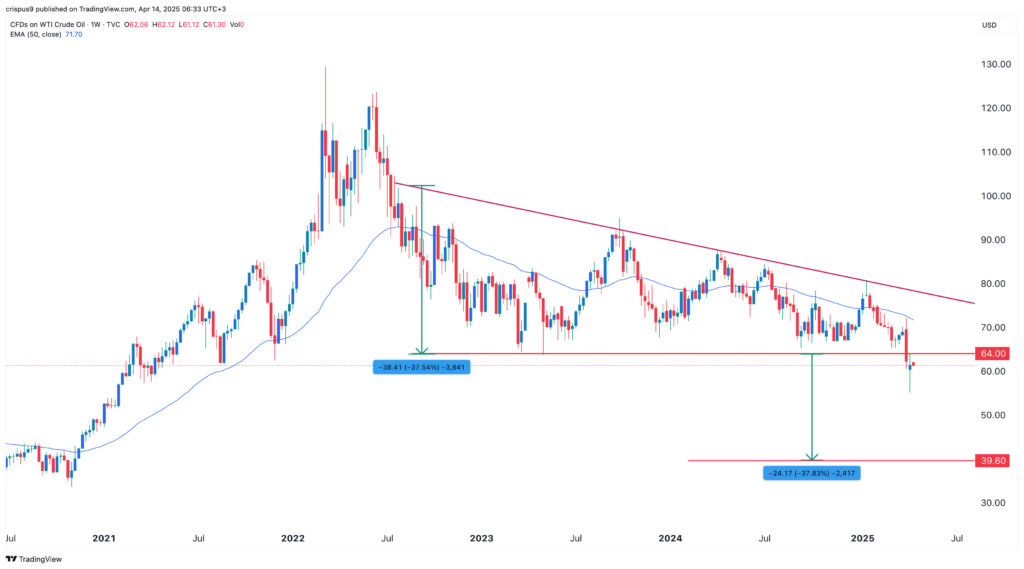
WTI crude oil price analysis: here’s why it may crash to $40
- WTI crude oil price has crashed in the past few months.
- Technicals and fundamentals point to further decline this year.
- The most likely scenario is where it drops to $40 in the near term.
The West Texas Intermediate (WTI) crude oil price has retreated this year as concerns about demand and supply remain. WTI, which is the America’s oil benchmark, dropped to $61.30, down by over 24% from its highest point this year. This article explores why the price will keep falling this year.
WTI crude oil price technical analysis
Copy link to sectionOne of the top reasons why the WTI crude oil price will continue falling is that it has formed a descending triangle pattern on the monthly chart. This triangle is made up of a horizontal line at $64, where it failed to move below several times since 2023, and a diagonal line that connects the highest swings since July 2022.
The crude oil price has moved below the 50 and 100-week Exponential Moving Avrages (EMA), a sign that bears are in control for now. Also, oscillators like the Relative Strength Index (RSI) and the MACD have continued falling.
Therefore, a combination of the descending triangle, trend indicators like moving averages, and oscillators like the Stochastic and Relative Strength Index (RSI), points to more downside in the coming weeks. The next point to watch will be at $40, which is derived from measuring the widest point of the triangle and then the same distance from the neckline.
The bearish WTI crude oil forecast will become invalid if the price rises above the upper side of the descending triangle indicator. This view is similar to our recent Brent forecast.

WTI crude oil price chart | Source: TradingView
Oil has weak fundamentals
Copy link to sectionThe bearish crude oil price forecast is also because of the weak fundamentals. First, analysts at the Energy Information Administration (EIA), International Energy Agency (IEA), and Goldman Sachs have all slashed their oil demand for the year, citing the ongoing trade war between the United States, China, and other countries. This war could lead to a recession, which will affect demand by over 600k barrels a day.
At the same time, there are concerns that the oil supply is set to increase. OPEC+ members have voted to boost production this year. Similarly, the US, under Trump, is expected to boost production as part of his drill, baby, drill policies. Trump hopes that lower oil prices will help to stabilize inflation in the country.
More supply wlll come from the ongoing talks between Russia and Iran. If they bear fruit, they will likely have a clause on sanctions relief, which will bring millions of barrels of oil online this year.
Therefore, WTI crude oil price will likely keep falling because of the demand and supply fundamentals that will remain under pressure this year. Falling oil prices will negatively impact energy companies like BP, Shell, Chevron, and Exxon that will see their margins thin over time. This explains why most energy ETFs have retreated lately.








